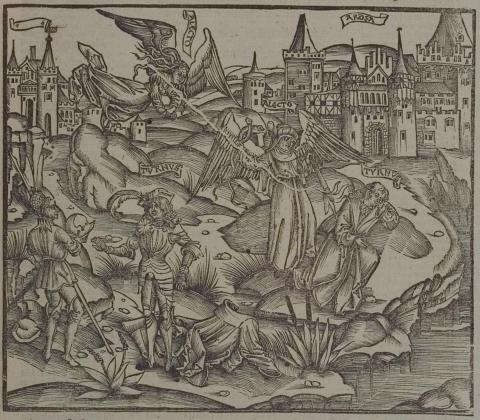Annotations
In the upper left, Allecto flies to the city of Ardea (408-13) which sits in the upper right. Within the city, she approaches the sleeping Turnus in a dream, which quickly becomes a nightmare. In the text, she appears first as the priestess of Juno and then takes her true form, in her efforts to goad Turnus to action (415-55). Brant's artist has portrayed her as a hybrid, with the headdress of a priestess but the wings and snakes of the Fury. She holds a torch to Turnus's back, which will cause him to wake from his nightmare (456-9). In the lower left, Turnus stands dressed in full armor with his night robe thrown on the ground behind him (460-2). He tells one of his chief warriors to arm for war (467-70).
Woodcut illustration from the “Strasbourg Vergil,” edited by Sebastian Brant: Publii Virgilii Maronis Opera cum quinque vulgatis commentariis expolitissimisque figuris atque imaginibus nuper per Sebastianum Brant superadditis (Strasbourg: Johannis Grieninger, 1502), fol. 299r, executed by an anonymous engraver under the direction of Brant.


Sebastian Brant (1458-1521) was a humanist scholar of many competencies. Trained in classics and law at the University of Basel, Brant later lectured in jurisprudence there and practiced law in his native city of Strasbourg. While his satirical poem Das Narrenschiff won him considerable standing as a writer, his role in the transmission of Virgil to the Renaissance was at least as important. In 1502 he and Strasbourg printer Johannes Grüninger produced a major edition of Virgil’s works, along with Donatus’ Life and the commentaries of Servius, Landino, and Calderini, with more than two hundred woodcut illustrations. (Annabel Patterson)